
|   |

|   |
 e-mail: leelakaverivenkat@gmail.com Nritya Veerangana - Brainchild of Dr. Sonal Mansingh Photos courtesy: Dr. Sonal Mansingh March 22, 2023 Why is it that while heroic exploits in any field evoke high praise and recognition, dance figures, who have been trendsetters and have contributed to changing the whole course and history of the art form in the country, do not elicit similar accolades? Nagged by the absence of dance names among Indian heroes, Rajya Sabha member/dancer/choreographer/scholar, Dr.Sonal Mansingh, conceived Nritya Veerangana- the indomitable Women of Dance, paying tribute to a few exceptional women from the world of Indian dance - the contribution of each treated through the dance form of the area the person hailed from. 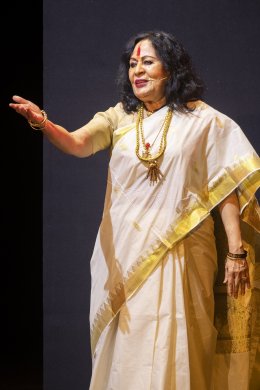 Dr. Sonal Mansingh Passionately supportive of the rights of subjugated woman in a patriarchal society, the theme and its presentation, have been conceptualised and sponsored by one, who has lived life on terms of equality with men, not cowed by societal norms. Given her ability for public speaking, Sonal Mansingh's introduction of each heroine was unique. It was strange for her, that dance as the most natural and earliest of man's expressions (represented in the earliest paintings on Bhimbetka caves), has not received the kind of attention it merits. Presented at Bharata Kalakshetra Auditorium in Chennai as part of the Remembering Rukmini Devi festival, it was a unique moment, with the opening work being dedicated to 19th century poet/courtesan Muddupalani (1739-1790), whose work in Telugu, Radhika Santvanam (appeasement of Radhika) comprising 584 poems was banned for its exuberant eroticism - to be revived by another great devadasi, Bangalore Nagaratnamma - the rescinding of the ban, with the restoration of the original unedited version of the work taking place only in 1947.   Kuchipudi by Vanashree Rao's group In what was the first ever dance-drama type of presentation of this work (solo interpretation of some verses was by senior dancer Swapna Sundari), it is commendable that Kuchipudi dancer/choreographer Vanashree Rao, hailing from Bengal, could cull out from a Telugu work, verses which could form the textual framework for dance composition - for heavily laden as Radhika Santvanam is, with overly explicit sexuality, a major part of it makes dance interpretation for an Indian audience, problematic. A great devotee of Krishna, Muddupalani's very treatment of the plot however, would seem to indicate the wayward, less dependable male (in this case, Krishna himself) against wronged woman (Radha here) who emerges as the stronger other half. The excellent ragamalika score conceived by Vanashree with music composition and rendition by Venkateshwaran, provided the right take-off point. Starting with Muddupalani's prayer to Krishna, set to raga Vachaspati, the group dance expression went on to a description of Krishna's beauty. Then begins the story, set to raga Kuntalavarali, of Krishna's infatuation for Ila, Radha's sakhi. Stricken Radha, retaining her composure, goes to the extent of advising mugdha Ila about how to respond to Krishna's love. ("Manasiju nigammalu bhinumani upadesam ichhi" was set to Basanti ragam). However, in a tisra gati tread, set to raag Jog, Krishna, pretty soon, returns in search of Radha. But deeply hurt Radha will have none of him, and her irritated sakhi answering the door says, "Konudoi mampeni kanamu nidra ledu, Radha pai baliche ratri ella". When Krishna persists, an irate Radha comes out asking (Evaru pilichi iccatiki, enduku avaccitivi?), "Who has called you and why have you come here?" Attacking Krishna like a Mahabhujangana (like a large snake, with hood raised), her foot aiming a kick at him, is lovingly held captive in Krishna's hand. He pleads that he does not want her foot hurt and entreats that she look at him with love and compassion. The finale in a melodious Sindhubhairavi in a ramya vrindavana arama has Radha/Krishna and the Gopis in a dance of joy. And as the concluding note comes the signature line Muddupalani pranitambana.... Very different in tone from the oft seen works, Vanashree's dancers did full justice to the choreography. While Washim Maheswara Raja made a graceful Krishna with his angashuddhi, Moutoushi Majumdar as Ila and Sakhi, and Monika Vaid as the other sakhi also showed themselves to be good, well trained dancers. But the honours belonged to Ayana Mukherjee as Radha. Apart from her graceful pure dance, she brought out the varying moods of Radha, with very sensitive abhinaya. 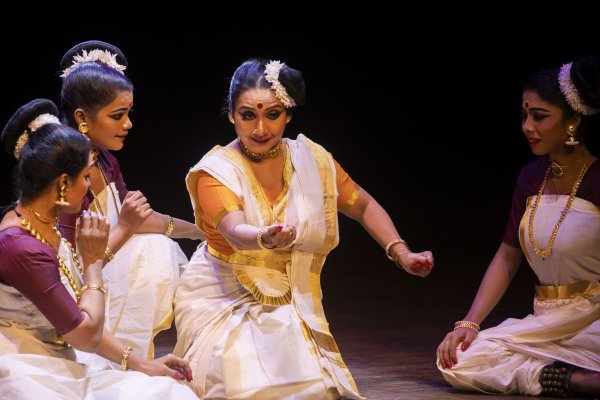 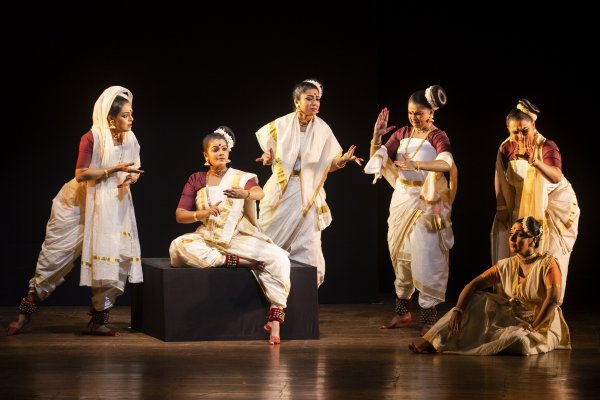 Mohiniattam by Neena Prasad and group The second heroine Kuriyedattu Thatri, born in a Namboodiri family, is amongst Kerala's strongest feminist voices. Reviled by society for fighting against a patriarchal system wherein women, habitually exploited to satisfy carnal desires of man, were the ones blamed by society, while the male walked free, she was married off to a much older, promiscuous Raman Namboodiri of Chemmanthite Kuriyedathillam when a bare 11-13 year old. Thatri was subjected to a difficult life till she broke free and began to live life on her terms - becoming a force for the rights of woman. Neena Prasad's Mohiniattam projection of Thatri, based on a text and script by M.J. Sree Chithran, strung to music composed by Madhavan Nampoothiri (rendered by singers Madhavan Nampoothiri and NJ Nandini) was the highlight of the evening.. Stung by constant attempts at reducing her to an outcast given to immoral living, the production begins with Thatri posing the question (Thinma nanmagal thookinokiya thatva needicharitrame), "Am I the culprit or is it the merciless hegemonic system of justice?" Drawing attention to her artistic prowess, she describes herself as Ragendhu manohari lasya vimohini ragini tharunya vallari Thatri! In the next scene, Ulli pollum kalangam, Thatri expresses her revulsion for carnal minded men, who, through supposedly ordinary touches, reveal their not-so-innocent intentions. In another scene, Thatri is shown enjoying her freedom, secretly mingling with Nair women, disguised as one of them, dancing with them during Thiruvathira. Believing in a society where both sexes have similar rights, she fearlessly makes advances through a padam in Begada, "Dhanye mal sakhi" expressing her love for Kathakali maestro Kavungal Shankar Panicker. In another scene, with the music in Natabhairavi, "Sumashara subhaganga mane" she admires his portrayal of Keechaka. Speaking of the greatness of sringar, Thatri eloquently declares that it is to this state-of-being that she owes her strength, and courage to face the world. Made to face the Namboodiri system of trying women for loose conduct through Smarthavicharana, she wonders (Kalpakanganayal suchinthitam set to raga Revati) if in search of her true role in society, she was the one who trapped men. Her sakhi asks her how she, by herself, could fight society as it was? (Kula vadhu mani moule, set to ragam Surati). "Ariven anthayavum sakhi" she answers in ragam Revati. " I know what will happen. They will try to demean me as a prostitute. But I will make sure they also fall along with me." And she does just that providing material and every other evidence necessary to prove how many men had had relations with her - and the long list she handed over to the jury, was full of some of the most prominent societal figures. It was after this historical fight of Thatri during the trial, that some of the Namboodiri customs were changed, with more equitable rights for women. One of the finest Mohiniattam exponents of today, the full impact of Neena Prasad's dance visualisation, replete with grace and interpretative conviction, could be gauged from the enthusiastic audience applause. The other well trained dancers in the group were Vidya Pradeep, Aswathy Krishna, Dhaneesha Dhanapal and Abhirami. The only distracting feature was that in a work covering such a long span of time - there were as many as eight scenes - after each scene, the stage went totally dark. One wonders if by using some visuals, (which they did in some places) they could have provided some form of continuity, sans so many breaks. 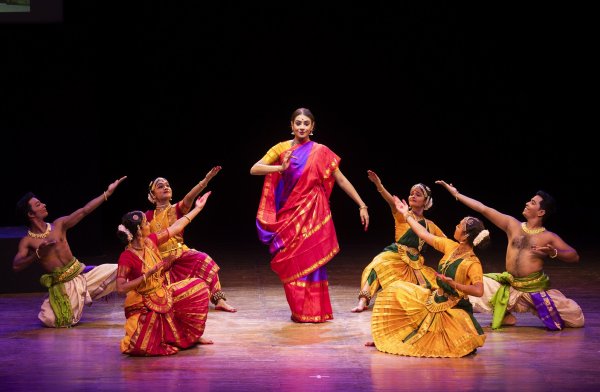 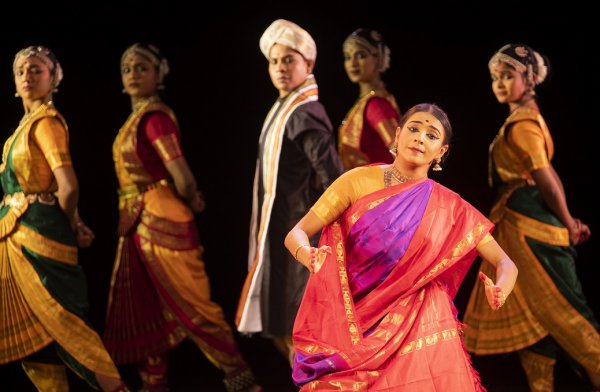 Bharatanatyam by PT Narendran's group The tribute to the last of the veeranganas in this presentation, Rukmini Devi, in the presence of her adoring followers, staged at the very venue of the dance haven that she founded, was bound to have a captive audience, and it did. A standing figure of Rukmini Devi (dancer Meghna) with a saree draped in the characteristic way, with the pallav loosely tucked in front, looking into space made a promising beginning. The choreographer P.T. Narendran looking at Rukmini Devi's career in Bharatanatyam, had rightly brought out important people playing a part in her life like Annie Besant, George Arundale, Krishna Iyer. Very significant was the salutary act of Guru Meenakshi Sundaram Pillai, after initial refusals, agreeing to take her on as a student (her initial introduction to the dance was through Gowri Ammal's abhinaya), of her starting of Kalakshetra and the new look given to Sadir, rechristened as Bharatanatyam. One could not fault the selection of the Mallari "Tathodaka tam tandan...", the Alarippu, compositions like Bharata kula bhagya kaliye, Jaya rangadhi devata, Ananda natana prakasham, "Bhava, Raga Tala, Bharatanatyam enru porruppadum" (singer O.S. Arun). Institutionalising Bharatanatyam teaching, introducing the male dancer into the dance as a performer, and treatment of the dance drama with the epoch making Ramayana series, were all Rukmini Devi's significant contributions. But for this critic, looking at Rukmini Devi only from the point of view of dance was somewhat limiting. Hers was a much greater contribution of looking at the art form as the expression emerging from a way of life, with aesthetics playing a part in every aspect. Her emphasis on the best of music supplied by giants in the field, on literature, on vegetarianism, her compassion for animals, how she turned a sandy area into a green haven, her accent on handloom, weaving, and on general education, all showed her as one much more than just a well-known figure in dance - her integrated approach did not get the emphasis it deserved in the visualisation of the work in her memory. True that time was limited - but this totality of approach could have been suggested in various ways through visuals. Productions woven round persona are difficult to conceptualise. But their contributions can provide good material for presentations.  Writing on the dance scene for the last forty years, Leela Venkataraman's incisive comments on performances of all dance forms, participation in dance discussions both in India and abroad, and as a regular contributor to Hindu Friday Review, journals like Sruti and Nartanam, makes her voice respected for its balanced critiquing. She is the author of several books like Indian Classical dance: Tradition in Transition, Classical Dance in India and Indian Classical dance: The Renaissance and Beyond. Post your comments Pl provide your name and email id along with your comment. All appropriate comments posted with name and email id in the blog will also be featured in the site. |